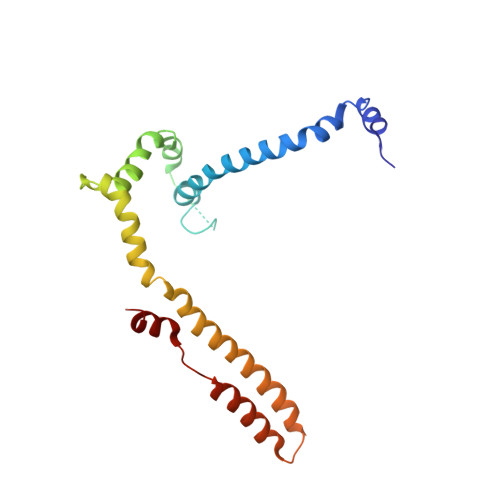NMR Model of the Entire Membrane-Interacting Region of the HIV-1 Fusion Protein and Its Perturbation of Membrane Morphology.
Piai, A., Fu, Q., Sharp, A.K., Bighi, B., Brown, A.M., Chou, J.J.(2021) J Am Chem Soc 143: 6609-6615
- PubMed: 33882664
- DOI: https://doi.org/10.1021/jacs.1c01762
- Primary Citation of Related Structures:
7LOH, 7LOI - PubMed Abstract:
HIV-1 envelope glycoprotein (Env) is a transmembrane protein that mediates membrane fusion and viral entry. The membrane-interacting regions of the Env, including the membrane-proximal external region (MPER), the transmembrane domain (TMD), and the cytoplasmic tail (CT), not only are essential for fusion and Env incorporation but also can strongly influence the antigenicity of the Env. Previous studies have incrementally revealed the structures of the MPER, the TMD, and the KS-LLP2 regions of the CT. Here, we determined the NMR structure of the full-length CT using a protein fragment comprising the TMD and the CT in bicelles that mimic a lipid bilayer, and by integrating the new NMR data and those acquired previously on other gp41 fragments, we derived a model of the entire membrane-interacting region of the Env. The structure shows that the CT forms a large trimeric baseplate around the TMD trimer, and by residing in the headgroup region of the lipid bilayer, the baseplate causes severe exclusion of lipid in the cytoleaflet of the bilayer. All-atom molecular dynamics simulations showed that the overall structure of the MPER-TMD-CT can be stable in a viral membrane and that a concerted movement of the KS-LLP2 region compensates for the lipid exclusion in order to maintain both structure and membrane integrity. Our structural and simulation results provide a framework for future research to manipulate the membrane structure to modulate the antigenicity of the Env for vaccine development and for mutagenesis studies for investigating membrane fusion and Env interaction with the matrix proteins.
Organizational Affiliation:
Department of Biological Chemistry and Molecular Pharmacology, Harvard Medical School, Boston, Massachusetts 02115, United States.














